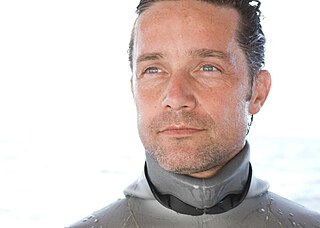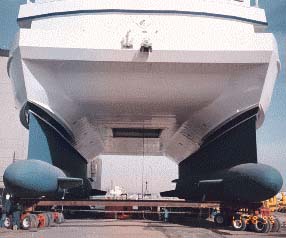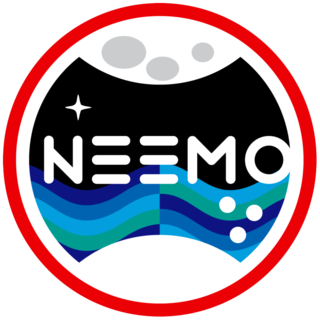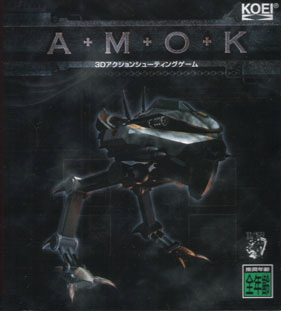
A submersible is an underwater vehicle which needs to be transported and supported by a larger watercraft or platform. This distinguishes submersibles from submarines, which are self-supporting and capable of prolonged independent operation at sea.

Michael Landon Gernhardt is a NASA astronaut and manager of the Environmental Physiology Laboratory, and principal investigator of the Prebreathe Reduction Program (PRP) at the Lyndon B. Johnson Space Center.

Underwater habitats are underwater structures in which people can live for extended periods and carry out most of the basic human functions of a 24-hour day, such as working, resting, eating, attending to personal hygiene, and sleeping. In this context, 'habitat' is generally used in a narrow sense to mean the interior and immediate exterior of the structure and its fixtures, but not its surrounding marine environment. Most early underwater habitats lacked regenerative systems for air, water, food, electricity, and other resources. However, some underwater habitats allow for these resources to be delivered using pipes, or generated within the habitat, rather than manually delivered.

The Little Mermaid is a licensed action game released in 1991 by Capcom for the NES and Game Boy based on the 1989 Disney film of the same name. It follows the plot of the original film with Ariel as the playable character. She swims through various underwater levels, battling enemies and collecting power-ups. It has an average rating of 4.78 out of 5 based on 23 user ratings.

Fabien Cousteau is an aquanaut, ocean conservationist, and documentary filmmaker. As the first grandson of Jacques Cousteau, Fabien spent his early years aboard his grandfather's ships Calypso and Alcyone, and learned how to scuba dive on his fourth birthday. From 2000 to 2002, he was Explorer-at-Large for National Geographic and collaborated on a television special aimed at changing public attitudes about sharks called "Attack of the Mystery Shark". From 2003 to 2006, he produced the documentary "Mind of a Demon" that aired on CBS. With the help of a large crew, he created a 14-foot, 1,200-pound, lifelike shark submarine called "Troy" that enabled him to immerse himself inside the shark world.

A moon pool is an equipment deployment and retrieval feature used by marine drilling platforms, drillships, diving support vessels, fishing vessels, marine research and underwater exploration or research vessels, and underwater habitats. It is also known as a wet porch. It is an opening found in the floor or base of the hull, platform, or chamber giving access to the water below. Because of its stable location, it safely allows technicians or researchers to lower tools and instruments into the sea.

Black Dawn is a helicopter-combat simulation, published by Virgin Interactive Entertainment. It was released on the Sony PlayStation and the Sega Saturn in 1996.

NASA Extreme Environment Mission Operations, or NEEMO, is a NASA analog mission that sends groups of astronauts, engineers and scientists to live in the Aquarius underwater laboratory, the world's only undersea research station, for up to three weeks at a time in preparation for future space exploration.

The Maracot Deep is a short 1929 novel by Arthur Conan Doyle about the discovery of a sunken city of Atlantis by a team of explorers led by Professor Maracot. He is accompanied by Cyrus Headley, a young research zoologist and Bill Scanlan, an expert mechanic working with an iron works in Philadelphia who is in charge of the construction of the submersible which the team takes to the bottom of the Atlantic.

Stanley Glen Love is an American scientist and a NASA astronaut from Oregon.

Amok is a 1996 mech-themed action video game for Windows and Sega Saturn. Players guide a robot called "Slambird" through nine different scenarios to complete several objectives. The game was noted for its use of voxel-based graphics for its environments rather than the polygonal models which were standard at the time of its release. Developed by Lemon, Amok began as a technology demo for the Sega 32X, but was reworked for the Saturn after Sega discontinued support for the 32X.
Lego Aqua Raiders was a Lego theme that was launched by The Lego Group in 2007 and discontinued the same year. The theme focused on a team of divers searching for treasure in the Bermuda Triangle. The product line consisted of seven construction toy sets released in the same year.
Philippe Victor Diolé was a French author and undersea explorer.

Everblue 2 is a scuba diving adventure game. It is the sequel to the game Everblue. Arika, the developers of both games, followed it with the spiritual sequel Endless Ocean, for the Wii.

Critical Depth is a vehicular combat game made for the PlayStation, developed by the game studio SingleTrac and published by GT Interactive. It was released on November 21, 1997.
The Undersea Adventures of Captain Nemo is a Canadian animated television series of five-minute cartoons produced in 1975 by Rainbow Animation in Toronto, Ontario. The series follows the underwater adventures of Captain Mark Nemo and his two young assistants, Christine and Robbie, in their nuclear-powered submarine, the Nautilus.

William Laurence Todd is a Project Manager for Exploration Analogs at NASA's Johnson Space Center (JSC) in Houston, Texas. He has also served as a NASA Undersea Research Team Project Lead and Spaceflight Training Simulation Supervisor at NASA JSC. Todd is a veteran Aquanaut of 5 missions. In 2001, he commanded the first NASA Extreme Environment Mission Operations (NEEMO) mission, a joint NASA-NOAA program to study human survival in the Aquarius underwater laboratory in preparation for future space exploration.

The World Is Not Enough is a first-person shooter video game developed by Black Ops Entertainment and based on the 1999 James Bond film of the same name. It was published by Electronic Arts (EA) and released for the PlayStation on November 7, 2000, shortly after the release of its Nintendo 64 counterpart. The World Is Not Enough is the successor to Black Ops Entertainment's 1999 title Tomorrow Never Dies and uses an improved version of its engine. The game received mixed reviews from critics, who criticised its short length and lack of multiplayer mode.
Diving support equipment is the equipment used to facilitate a diving operation. It is either not taken into the water during the dive, such as the gas panel and compressor, or is not integral to the actual diving, being there to make the dive easier or safer, such as a surface decompression chamber. Some equipment, like a diving stage, is not easily categorised as diving or support equipment, and may be considered as either.

TigerShark is a 1997 video game published by GT Interactive for the PlayStation and Windows, and the first game to be released by its developer, n-Space.
















